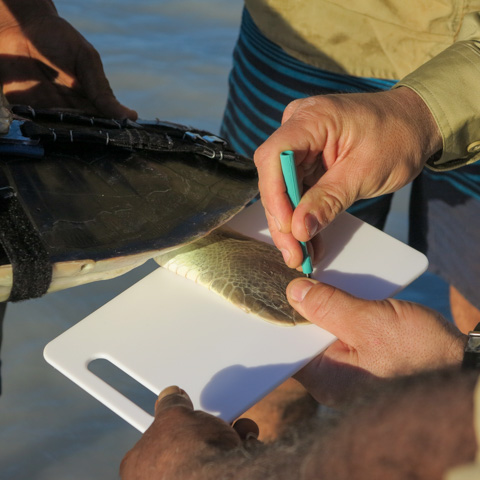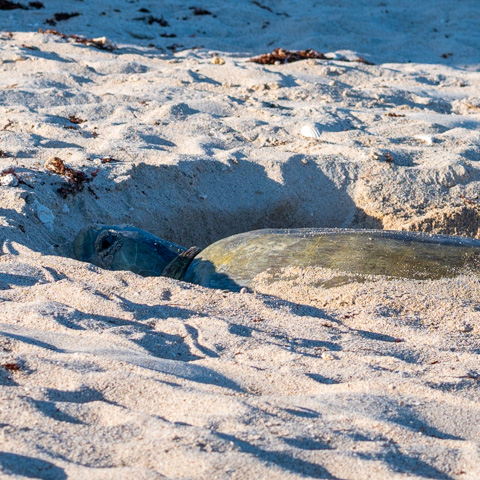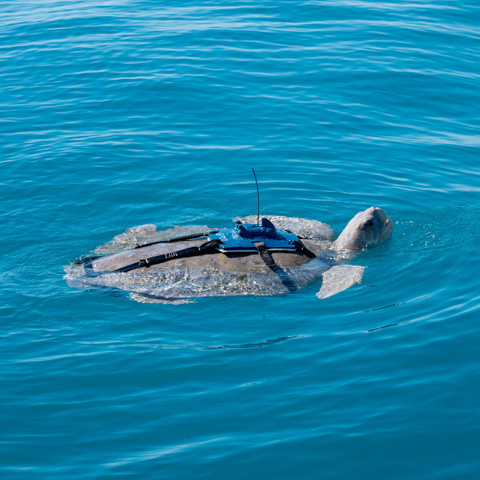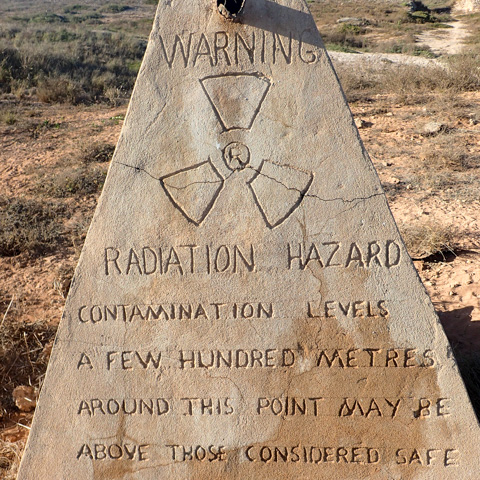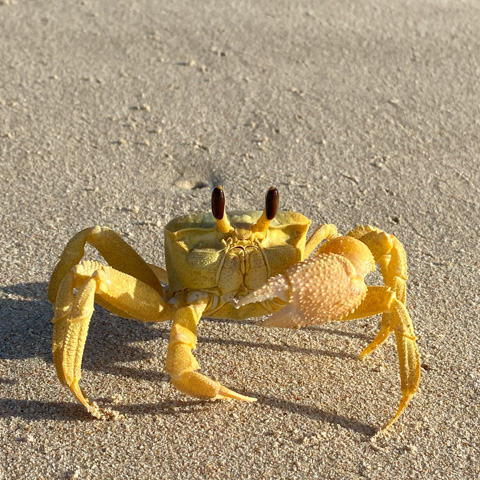Understanding the lives of flatback turtles
A flatback turtle's life cycle is different to other marine turtles in that they lack an oceanic life-stage; instead post-hatchlings and juveniles stay within the relatively shallow continental shelf in Australian waters. Understanding the unique life cycle and behaviour of the flatback turtle allows for the effective development and implementation of conservation strategies.
What we know so far
Research on the life cycle and behaviour of flatbacks is diverse. The program has explored the thermal biology of eggs and embryos (e.g. thermal traits, metabolic heat), the benefits and challenges of targeting conservation strategies towards different life stages, and the use of skeletochronology and genetics to understand age and growth of flatback turtles.
Research has also focused on understanding diving behaviour, how hatchlings use wave characteristics to assist in their journey away from shore, physical and behavioural defences flatback turtles develop to protect themselves from predators, and how artificial intelligence can be used to assist in our understanding of turtle behaviour.
AI flatback turtle research video to go here
Research highlights
Researchers turned to artificial intelligence (AI) to sift through billions of data points to uncover how the flatback turtle uses habitat in Broome's Yawuru Nagulagun Roebuck Bay, Western Australia. Multi-sensor data loggers were attached to individual turtles and over 100 days of data were collected. By using video footage from some turtles to ground-truth the data, researchers taught the AI system how to accurately predict underwater behaviours of turtles from sensor data alone.
This innovative technique shows that turtles rest and forage in the same locations, however they will change locations depending on time of the day and tidal conditions, but also throughout the year depending on seasonal differences in water temperature. Understanding how turtles are using different parts of their habitat throughout the year is critical for conservation planning and prioritising actions. The development of this technique could also be the key to unlocking the unseen behaviour of other threatend marine species.
This research was led by Murdoch University's Harry Butler Institute (see more of their work at www.peaclab.org), in collaboration with DBCA/NWSFTCP, DBCA/Yawuru Marine Park Rangers and Nyamba Buru Yawuru Country Managers. The research was supported by the Ecological Society of Australia's Holsworth Wildlife Research Endowment.
Flatback turtles spend much of their lives underwater, diving for extended periods of time and briefly coming to the surface for air. Little research has been done on the behaviours performed during these dives, with all previous research on flatback turtle diving behaviour being categorised only by time and depth of the dive. Biologging technology (animal-borne tags) is now advanced enough that high-resolution sub-second data from multiple sensors can be collected simultaneously.
Researchers worked to develop an analytical method that can be used to interpret complex diving behaviour from such data, collected from flatback turtles at Yawuru Nagulagun Roebuck Bay Marine Park. The result was a detailed interpretation of diving behaviour during the poorly understood foraging life-history stage of flatback turtles. For example, dives that would have been categorised as 'resting' using only time-depth data were found to be multi-purpose dives where the turtle performed multiple behaviours during the same dive, such as foraging and resting.
This research was led by Murdoch University's Harry Butler Institute (see more of their work at www.peaclab.org), in collaboration with DBCA/NWSFTCP, DBCA/Yawuru Marine Park Rangers and Nyamba Buru Yawuru Country Managers, Simon Fraser University, and Curtin University. The research was supported by the Ecological Society of Australia's Holsworth Wildlife Research Endowment.
Using an approach called skeletochronology (counting the annual growth lines in marine turtles’ bones to estimate age), researchers discovered how old flatback turtles are when they begin laying eggs and how long they can reproduce for. By observing the number of rings in the bones, it was discovered that the average age flatback turtles begin reproducing is 16 years old, which is younger than originally thought. Based on the 74 turtles studied, it was also found that flatback turtles could reproduce for up to 31 years, with the oldest nesting turtle found being 48 years old.
This research was led by The Ocean Foundation and NOAA National Marine Fisheries Service, in collaboration with DBCA/NWSFTCP, Department of Environment and Science Queensland, Charles Darwin University, and Pendoley Environmental.
Marine turtle hatchlings are thought to use wave characteristics to aid in their navigation from the shore to the oceanic waters. Considering flatback turtles do not have an oceanic development phase and spend their developmental years in coastal waters, researchers wondered if they would respond to wave characteristics in the same way as other marine turtle species.
Through the use of a wave tank to simulate both sea and swell waves that are commonly experienced at nesting locations and monitoring the swimming direction of flatback hatchlings in the tank, researchers were able to confirm that they do use waves for navigation when they enter nearshore waters. The hatchlings were able to detect and respond to wave cues, and preferred faster waves.
This research was led by The University of Western Australia and the Australian Institute of Marine Science, in collaboration with DBCA/NWSFTCP and Pendoley Environmental.
Publications
2024
2023
2022
- Multivariate analysis of biologging data reveals the environmental determinants of diving behaviour in a marine reptile
- Age-specific growth and maturity estimates for the flatback sea turtle (Natator depressus) by skeletochronology
2021
- Metabolic rates and thermal thresholds of embryonic flatback turtles (Natator depressus) from the North West Shelf of Australia
- Animal-borne video from a sea turtle reveals novel anti-predator behaviours
- Nearshore wave characteristics as cues for swimming orientation in flatback turtle hatchlings
2020
- Variation in thermal traits describing sex determination and development in Western Australian sea turtle populations
- A systematic review of metabolic heat in sea turtle nests and methods to model its impact on hatching success
- Lifespan estimation in marine turtles using genomic promoter CpG density
2016
Researchers

Dr Scott Whiting
Principal Research Scientist
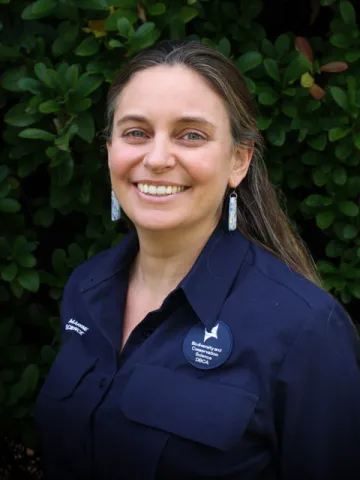
Dr Sabrina Fossette
Senior Research Scientist

Dr Tony Tucker
Senior Research Scientist






